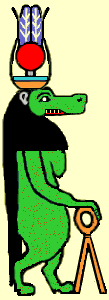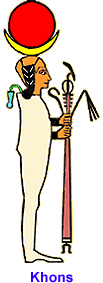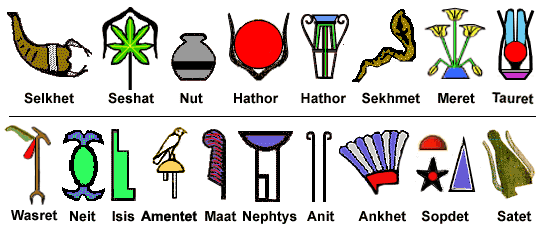|
|
01/02/2012
pics for school
    


imsety
In Egyptian mythology, Imseti (also transcribed Imset, Amset, sety, Mesti, and Mesta) was a funerary deity, one of the Four sons of Horus, who were associated with the canopic jars, specifically the one which contained the liver. Unlike his brothers, Imsety was not associated with any animal and was always depicted as human. The early form of Isis was considered his protector.
Imsety is one of the four sons of Horus, he was portrayed as a mummified human.
Horus (the elder) had numerous wives and children, and his 'four sons' were grouped together and generally said to be born of Isis. Imsety was one. The other three were Duamutef, Hapyand Qebehsenuef. They were born from a lotus flower and were solar gods associated with the creation. They were retrieved from the waters of Nun by Sobek on the orders of Re. It was believed that Anubis gave them the funerary duties of mummification, the Opening of the Mouth, the burial of Osiris and all men. Horus later made them protectors of the four cardinal points (north, south, east and west). In the Hall of Ma'at they sat on a lotus flower in front of Osiris. Most commonly, however, they were remembered as the protectors of the internal organs of the deceased. Each son protected an organ, and each son was protected by a goddess.
Imsety's role was to protect the liver of the deceased and was the guardian of the South. He was protected by the goddess Isis.
imsety

all agyption gods
Ancient Egypt had by tradition a great variety of gods and what today can be labeled as spirits and divine forces. Some were depicted just as symbols and others had the form of living createures.
In total they were over 2.000(!) but many had similar characteristics and appeared all over the country but with different names. This great diversity is due to the fact that before the country was united the northern Nile Valley was split up into about forty self ruling areas (later to be provinces - called nomes) where the ruling tribes had their own deities and leaders.
From the dualism of all gods it's clear that animals were the first to get divine status and by time got human form.
Because of this all gods had two things in common - they were family members with counterparts from the opposite sex and manifested them- selves on earth through animals.
Thus the local wild fauna of birds, crocodiles, snakes, turtles, frogs, plus cattle, dogs, cats and other domesticated animals were considered to be the living images of a particular god or goddess and a natural and indestructible part of the environment in which people lived.
All parts of life were covered and there were gods for - beer, plants, digestion, the high seas, female sexuality, gardens, partying etc. Many of them had lots of duties and were with time combined with each other in a great number of ways.
Some of them could appear in rather unusual forms like a goddess (curious even by Egyptian standards) having a head of a bee and body from a hippopotamus.
When having a glance at a depiction of them shown in upright position with human bodies, the goddesses are easy to single out since they always had their legs joined together, while the males used to be seen on the move - striding.
 Taueret Taueret |
Different towns struggled to have just their local gods at top of the state religion and thus we have many different religious legends over the years depending upon which town had the greatest politi-cal influence during the period. To increase the number of sup-porters nation wide they could "borrow" abilities from popular gods and give to their own. Because of this over the years different gods came into fashion and later went out of style, with exception of a group that was in front right from the beginning and never lost its popularity. These were responsible for basic and vital things in life like love, joy, dancing, childbirth, justice, and life after death.
All aspect of daily life were covered by at least one of these deities, and like people on earth a vast majority of them were married (of- ten to their siblings) and had children.
Many ingredients made it possible for common people to identify themselves with them since their personalities were made of both divine strength and human weakness. They did most of the things that ordinary people did, like harvesting, hunting, eating, drinking, partying and even dying. Most of them were depicted as men and women combined with the head of the animal by which they were represented and they could appear in different costumes and be represented by several animals in the Egyptian fauna.
In other words - they could appear in many ways and yet some of them were so alike looking that it's impossible to identify them without reading the connecting text. Just looking at the dresses and the regalia they carry along isn't always enough, because they used to borrow objects from each other. This guesswork is a part of the charm when looking in to their in many ways, to us, unlikely world.
As to their names, today we use a blend of both their original Egyptian ones like Re, Ptah and Amon, and the Greek forms like Isis, Osiris and Horus.
Shrines
As for the veneration of the gods scholars of Egyptology doesn't know exactly how this was made during the oldest times, or at what point in history the main gods had cult areas replaced by temples of their own.
One clue might be the god Min (see him) who obviously had a very old cult at Koptos in Upper Egypt where two statues of him larger then life size were found in the late 1800s. They had no doubt been situated within a sacred area or by a shrine of some sort, but no remains are left to reconstruct what it may have looked like.
After the formation of two separate countries along the Nile (Upper and Lower Egypt) a typical building came to be in each part, which more or less symbolized the country itself in both a religious and political way and underlined its national identity.
 |
It's most likely that local temples made of clay and reed originally were the cult buildings used by tribes along the Nile, and with time two shrines were specified where people could make offers to the main gods. Through their different designs it's easy locate the origin of old writings found since their depictions were incorporated into the hieroglyphic signs at an early stage (shown to the right of each illustration above).
Per-wer, meaning "the Great House", stood for Upper Egypt, and Per-nu, "the House of Flame" was the cupola shaped roofed national temple of Lower Egypt.
They are both attested for already during the reign of pharaoh Aha at the beginning of the first dynasty where they are present on a famous wooden label.
If at this stage, all mayor gods were worshipped in these buildings is not known.
With time the temples were elaborated to be great stone building just for a few very popular gods and goddesses which had fame over the centuries throughout the long Egyptian history. Minor gods had small shrines or were venerated in the homes.
Clothing
When the goddesses and gods were depicted with a human body the variety wasn't so big in the way they were dressed. Less then half a dozen types of garments covers almost all of them. From the beginning they all wore white dresses, or at least single colored. This tradition slowly changed over the years and with time the colors and patterns became elaborated. The peak was reached during the Greco-Roman period when they were seen in outfits like actors in a costume spectacle in a theatre.
Excluding the mummy-like creations, here is a type description in brief:
 |
- Tunic with suspenders.
Male garment, ending above the waist
and popular in all times. Example:Re.
- Dress with suspenders.
Female garment, ended above the waist,
and was usually white. Example:Hathor.
- The short loincloth
Short and skirt-like garment and popular from earliest times. Example: Asar-hap.
- The short-sleeved overall
From the earliest times very common
tight female garment. Example:Isis.
- The full-length dress
Unusual, sleeve-less and for goddesses.
Went up to the neck. Example:Seshat.
|
 |
Notice that long sleeves were not in fashion in any era of Egyptian history, at least for the gods and goddesses. Their dresses were to a great extent similar to those worn by the upper classes in society during daytime and evenings, and mostly indoors.
Pharaoh's crown
The gods had a lot of different things to put on their heads, and they surely did. In bright contrast to the stereotyped positions of their bodies the painters and sculptors were keen on giving the heads as much attention as possible. This was obviously initiated by pharaoh himself or the priesthood in order to give their favorite gods as much promotion as possible. The different crowns could give a hint where the god originally came from, and by wearing the combined crown for the whole country, the message was given that this god or goddess was important to all Egyptians. To make them conspicuous all crowns, hats etc. were adorned with plumes, horns, snakes, flowers, sun discs, leaves etc painted in bright colors. Especially during the Greco-Roman era the fantasy and elaboration was significant.
 |
| Deshret Hedjet Peshent Peshent Atef Atef with horns Khepresh |
|
EGYPTIAN CROWNS: The red one was from Lower and the white from Upper Egypt.
The double crown represented the whole country. The Atef-crown was worn by Osiris and the type with horns and the sun disc by Re-Horakhte and other gods. The blue helmet-like came during dynasty 18 and was worn by kings and the god Amon.
|
Headgears of the gods
Besides royal crowns the gods had a lot of other symbols and things to wear upon their heads. In some cases the headgear was necessary to identify the deities in ques-tion, when they were dressed the same, as they often were. Here is a selection of per-sonal things helping to identify which goddess is depicted in case the written hiero-glyphs don't give a clue. The following objects below are shown as they looked when the bearer in question was facing right.
Neit had the a stylised form of her shield and crossed arrows on her head. Isis wore a throne on top, a rather uncomfortable one it seems, and Maát had her standing ostrich feather she was named after. Nephtys had a building topped with a bowl-like object (for collecting rain water?) and Nut had a pot (or a broad vase) upon her head.
Selkhet wore the dangerous scorpion (without its deadly sting), and Seshat had the holy Persea-tree with two horns over it as her personal sign. Anat had a stylized cow's uterus as her token.Hathor had several objects in her hat box like cow's horns with the sun disc and her favorite musical instrument - the sistrum, which was a rattle.



  

|